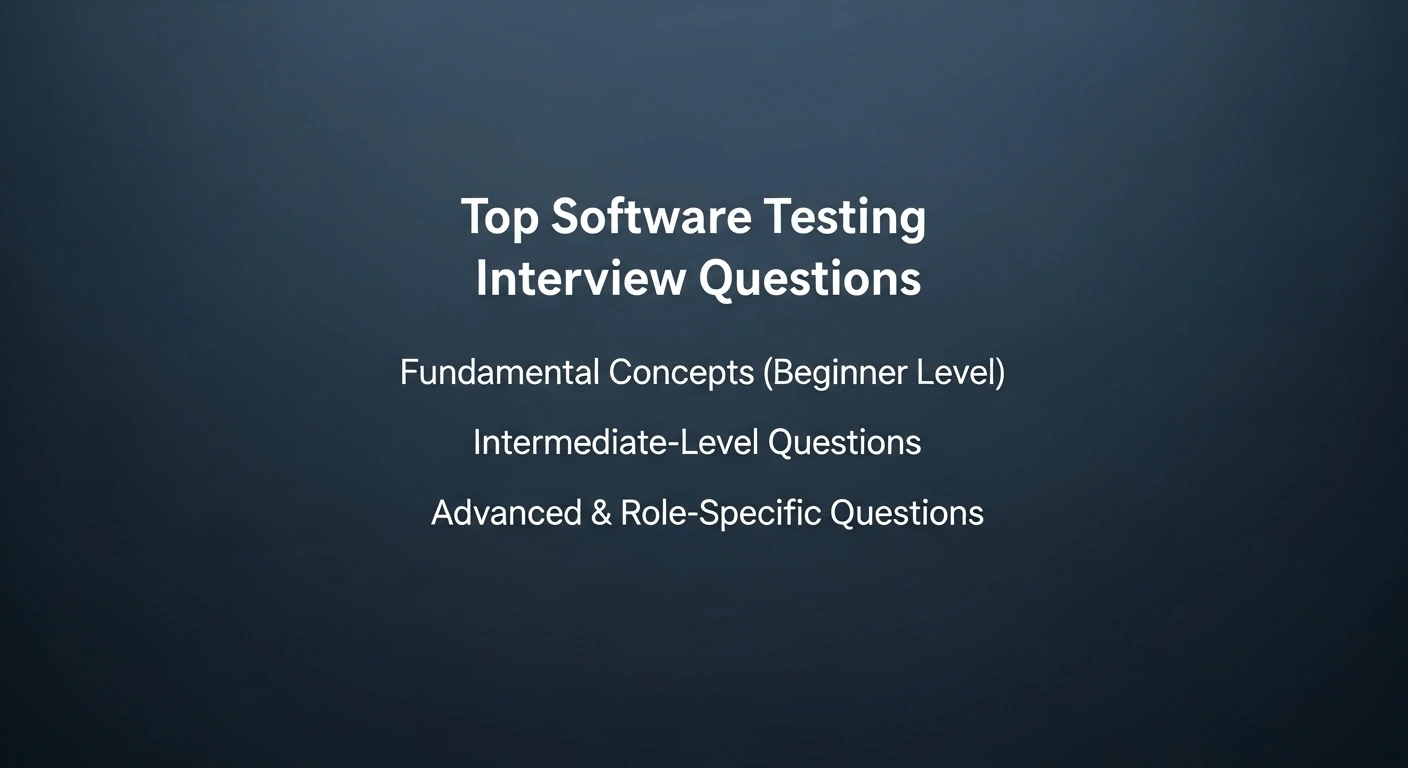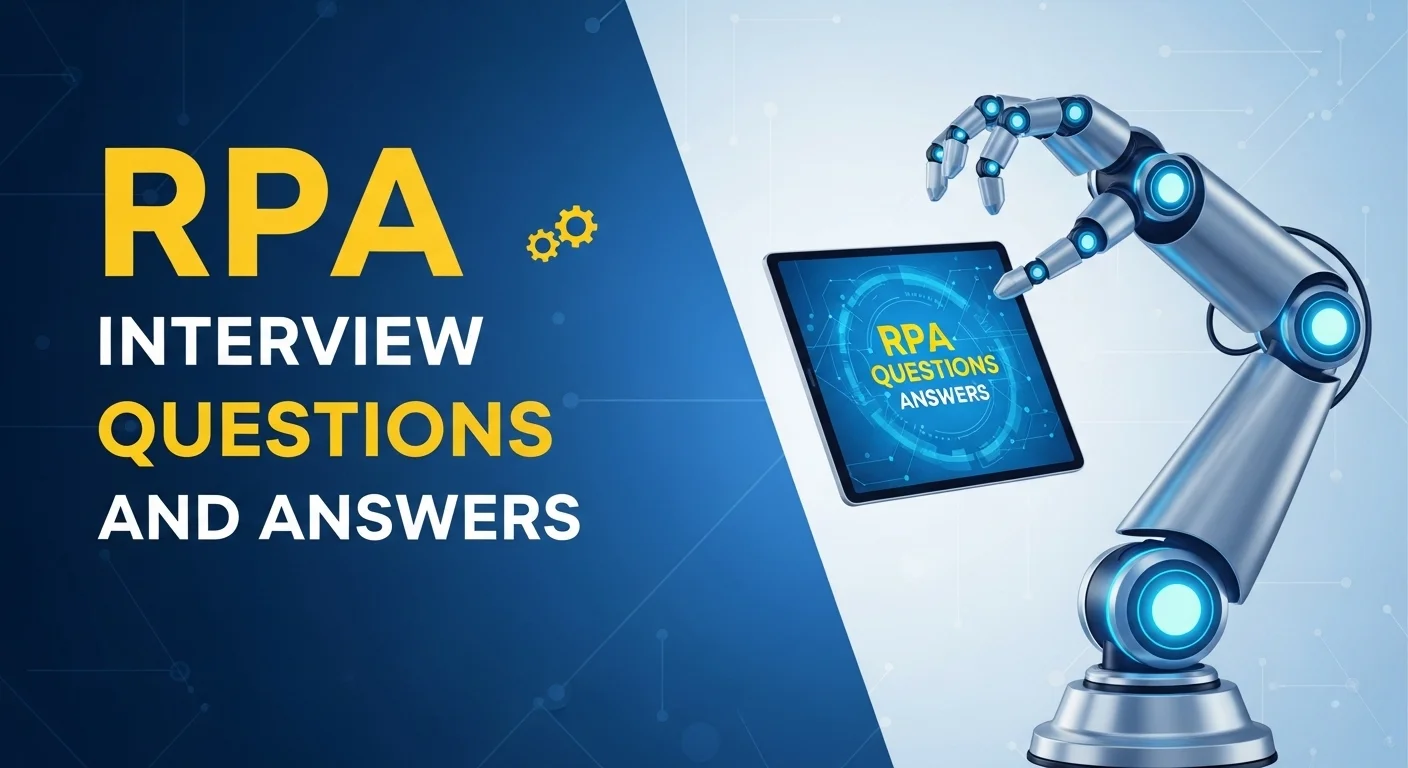Preparing for a software testing interview in 2025 is about more than memorizing definitions; it’s about showing adaptability to fast-evolving trends like automation, AI-assisted testing, DevOps integration, and continuous delivery. If you’re new to QA, it’s worth brushing up with a free structured course like Software Testing Fundamentals, which covers the basics before you dive into interview prep.
Learn key concepts such as SDLC, testing models, documentation, and more in this free Software Testing course. Master essential skills and tools necessary for building specialized applications.
This article compiles the Top 55 Software Testing Interview Questions for 2025, organized by difficulty and topic, to help candidates build confidence. Use it as a guide for study, mock interviews, and structuring both behavioral and technical answers.
Fundamental Concepts (Beginner Level)
If you’re preparing for a Quality Analyst or Automation Test Engineer interview, these are the bread-and-butter concepts every interviewer expects you to know. Think of this section as your warm-up; simple questions that set the tone for deeper discussions later.
1. What is Software Testing?
Software testing is about making sure the product works the way it should. It’s not just about “finding bugs”, it’s about verifying that the software delivers value, meets requirements, and behaves consistently under real-world conditions.
2. Why is software testing important in SDLC?
Without testing, software is just guesswork. Bugs caught late in the SDLC are expensive to fix and can ruin user trust. Testing ensures quality from day one, reduces risks, and helps teams release with confidence.
3. What are types of testing: Manual vs Automation?
- Manual Testing: is human-driven. Good for exploratory work and cases where usability matters.
- Automation Testing: uses scripts and tools to cover repetitive tasks, regression, or large data sets. In practice, teams usually balance both approaches.
Also Read: Manual Testing Interview Questions
4. Explain the Software Testing Life Cycle (STLC).
Think of STLC as a mini-lifecycle inside the broader SDLC. The stages include:
- Requirement analysis
- Planning and strategy
- Designing test cases
- Setting up environments
- Execution
- Test closure and reporting
Each phase keeps the process structured and traceable.
5. What is the difference between SDLC and STLC?
- SDLC: The entire journey of software creation, from idea to deployment.
- STLC: A focused slice of that journey, zeroing in on testing activities.
6. What is test case, test scenario, test suite?
- Test Case: A step-by-step check of a specific function.
- Test Scenario: A broader condition (e.g., “Verify checkout process”).
- Test Suite: A group of related test cases bundled for execution.
7. What is defect / bug, defect life cycle?
A defect (or bug) is simply when the system doesn’t behave as expected. Defects pass through stages like: New → Assigned → Open → Fixed → Retested → Verified → Closed (or Reopened if still broken).
8. Severity vs Priority in Defects.
- Severity: How badly it affects the system (e.g., a crash vs a typo).
- Priority: How soon it needs fixing (e.g., a typo on a homepage might get fixed faster than a rare crash in an unused feature).
9. What is functional vs non-functional testing?
- Functional Testing: Checks what the system does (features, workflows, business logic).
- Non-functional Testing: Checks how it performs (speed, security, scalability, usability).
10. What are the types of non-functional testing?
Common non-functional testing types include:
- Performance testing – response times.
- Load testing – behavior under expected demand.
- Stress testing – how it reacts under extreme demand.
- Security testing – protecting data and access.
- Usability testing – how intuitive it feels to real users.
- Compatibility testing – works across devices, browsers, OS.
Intermediate-Level Questions
These are more technical questions, often asked of candidates with hands-on experience in testing.
11. What are test design techniques (e.g., Equivalence Partitioning, Boundary Value Analysis, Decision Tables, State Transition)?
- Equivalence Partitioning: Splits input data into valid/invalid partitions.
- Boundary Value Analysis: Concentrates on edge conditions (min/max, off-by-one).
- Decision Tables: These are used to capture complex business rules comprising of numerous conditions.
- State Transition Testing: Tests system behavior across states (e.g., login/ logout).
12. What is exploratory testing vs ad-hoc testing?
- Exploratory Testing: Test design, execution, and learning simultaneously in a systematic way.
- Ad-hoc Testing: Informal testing that is not structured, which is based on the intuition and experience of the tester.
13. Static testing vs Dynamic testing.
- Static Testing: Reviewing requirements, code, or design without executing the software (e.g., inspections, reviews).
- Dynamic Testing: Running the code to validate behavior and outputs (e.g., functional, performance tests).
14. What are some test environment & test data management challenges?
- Data privacy (GDPR/PII compliance).
- Creating realistic, production-like datasets.
- Environment instability or configuration drift.
- Limited access to required hardware, tools, or integrations.
15. What is test automation? When should you automate / not automate?
- Test Automation: Using tools/scripts to execute tests automatically.
- Automate when: Tests are repetitive, regression-heavy, data-driven, or performance-critical.
- Avoid automating: Exploratory, usability, or one-off test cases where human judgment is needed.
16. What is a test automation framework? Examples.
A test automation framework is a structured set of guidelines, libraries, and tools that standardize test creation and execution.
Examples: Data-driven, Keyword-driven, Hybrid, Page Object Model (POM), Behavior-Driven Development (BDD).
Maintaining a growing suite can get messy, overlaps, redundant tests, or long execution times. Here’s a practical guide on managing automation test suites using SQL and visualization that many QA leads find useful
17. What is Page Object Model (POM), or other abstraction patterns in automation?
- POM: This is a design that has its pages/parts of the application in the form of a class and as a result, the tests are also modular and maintainable.
- Other patterns: Screenplay pattern, data-driven tests, or reusability based on object repositories.
18. What is CI/CD and how does testing fit into CI/CD pipelines?
- CI (Continuous Integration): Automated unit tests, automated builds, and frequent combination of code.
- CD (Continuous Delivery/Deployment): Automating deployment to production.
- Testing role: Automated unit, API, UI, and regression tests run at different pipeline stages to prevent defects from reaching production.
19. What is the test pyramid / test strategy for prioritizing different kinds of tests?
The Test Pyramid emphasizes:
- Unit Tests (base): Rapid, numerous, consistent.
- Integration/API Tests (middle): Moderate number, validate services.
- UI Tests (top): Few, slower, end-to-end checks.
This assists in the balancing of coverage and speed and maintainability.
20. How to perform regression testing; what kind of regression to automate?
Regression testing ensures new changes don’t break existing features.
- Approach: Re-run impacted areas + critical workflows.
- Automate: Test cases that are stable, repetitive and that are business critical in order to enable faster execution.
21. What is performance testing, load, stress, soak/endurance testing etc.?
- Performance Testing: Generality and speed.
- Load Testing: Behavior under expected load.
- Stress Testing: A limit of system when it is overloaded.
- Soak/Endurance Testing: Stability under sustained, long-term usage.
22. How do you handle compatibility / cross-browser / cross platform testing?
- Use cloud platforms (e.g., BrowserStack, Sauce Labs).
- Prioritize based on user demographics (OS, devices, browsers).
- Automate regression across multiple environments to reduce effort.
23. How to test third-party integrations or APIs?
- Check request/response formats, errors and timeouts.
- Use API testing tools (Postman, RestAssured).
- Simulate unavailable services with mocks/stubs.
- Check backward compatibility with API versioning.
24. What are some common tools for automation, performance, security, etc., and criteria for choosing them?
- Automation: Selenium, Cypress, Playwright.
- Performance: JMeter, Gatling, Locust.
- Security: OWASP ZAP, Burp Suite.
Criteria: Ease of use, integration with CI/CD, scalability, community support, cost.
Also Read: Selenium Interview Questions
25. What are metrics / KPIs in testing (e.g., test coverage, defect density, DRE, pass rate)?
- Test Coverage: % of requirements/code tested.
- Defect Density: Defects per size (e.g., per 1,000 LOC).
- Defect Removal Efficiency (DRE): % of defects caught before release.
- Pass Rate: % of executed tests that pass.
- Mean Time to Detect/Fix (MTTD/MTTF): Speed of identifying & resolving issues.
Advanced & Role-Specific Questions
These questions are often asked of senior QA engineers, leads, or testers specializing in automation, DevOps, or large-scale systems.
26. How to design a test strategy for a large, complex system (microservices, distributed, etc.)?
- Subdivide the system into services/ modules.
- Define scope: unit, integration, contract, and end-to-end testing.
- Apply service virtualization/mocks to unavailable dependencies.
- Prioritize based on risk, business value, and critical paths.
- Integrate automated regression with CI/CD pipelines for frequent validation.
27. What are shift-left, shift-right testing practices?
- Shift-Left: Testing at an earlier stage in the SDLC (static code analysis, unit tests, CI integration) to uncover defects.
- Shift-Right: Production testing (feature flags, canary releases, monitoring, chaos testing) to test in the real world.
28. What is Behavior Driven Development (BDD), Test Driven Development (TDD), and their benefits / trade-offs?
- TDD: Test first then code in it, TDD enhances code quality and design, however, it may also be time consuming.
- BDD: Use natural language (e.g. Gherkin) to write tests to keep devs, testers and business stakeholders in sync.
- Trade-offs: They both enhance collaboration and coverage, but can introduce overhead when not managed well.
29. What is model-based testing or risk-based testing?
- Model-Based Testing: Develop abstract system behavior models to automatically generate test cases. Useful for complex logic.
- Risk-Based Testing: focuses on business/technical risks as the first priority, and then test high-impact areas.
30. Parallel test execution and scaling test runs (cloud, containers, grid).
Parallel execution of run tests between environments in order to shorten execution time.
- Scale with containerized environments (Docker, Kubernetes).
- Cloud-based solutions (e.g., Selenium Grid, BrowserStack, Sauce Labs) enable distributed test execution across devices/browsers.
31. Automation in performance / security testing (e.g., integrating security / vulnerability scans).
- Introduce performance tools (JMeter, Gatling) into pipelines to monitor on a continuous basis.
- Automate vulnerability scanning using OWASP ZAP, Burp Suite or dependency checkers.
- Conduct automated checks as part of CI/CD to identify regressions at an early stage.
32. Ensuring test maintainability and reusability (design patterns, modularity, object repositories, data-driven / keyword-driven frameworks).
- Apply design patterns (e.g., Page Object Model, Screenplay).
- Reuse test code through modularization.
- Centralize locators in object repositories.
- Use data-driven approaches for varied inputs and keyword-driven frameworks for readability and flexibility.
33. Handling flaky tests: causes, detection, mitigation.
- Causes: Timing, network problems, environment setups, and test dependency.
- Detection: Find out tests that fail periodically with each run.
- Mitigation: Add waits/synchronization, isolate tests, stabilise environments, and refactor test code.
34. Testing in DevOps / continuous delivery / continuous deployment contexts.
- Automate unit, integration, and regression tests within pipelines.
- Shift-left with static analysis, linting, and unit tests.
- Shift-right with monitoring, logging, and canary releases.
- Use infrastructure-as-code for consistent environments.
35. Reliability, resilience, and chaos testing.
- Reliability: System performs consistently over time.
- Resilience: Capacity to withstand failures in a graceful manner.
- Chaos Testing: Intentionally inject failures (e.g., shutting down nodes) to validate fault tolerance. Tools: Chaos Monkey, Gremlin.
36. Testability: how to improve testability in code / design (logging, observability, modularity etc.).
- Add observability to systems (logs, metrics, tracing)
- Loosely coupled, modular code makes the code more testable.
- Provide monitoring and automation hooks/APIs.
- Use feature flags for testing in production.
37. Using AI / ML in testing: where it helps, where it may mislead.
- Helps: Risk regions prediction, test case generation, test flakiness, visual testing, and anomaly detection.
- May mislead: Too much use of auto-generated tests, unintelligible, false positives/negatives in prediction.
It can be best applied as an addition rather than a substitute to tester's judgment.
Behavioural & Situational Questions
Roles in testing not only demand technical expertise, but also good problem-solving, communication, and leadership skills. These questions will look at how you have managed real-life situations.
38. Describe a challenging defect you found and how you resolved it.
Give an actual example: describe what was wrong, how you discovered it, how difficult it was to reproduce, debug, work with the developers, and the final solution. End with lessons learned.
39. How do you prioritize test cases when time is limited?
- Pay attention to important business functionality and areas of risk.
- Rank by severity, user impact, and defect history.
- Run smoke/sanity tests to ensure core stability.
40. How do you communicate bugs to developers/stakeholders?
- Prepared bug reports containing steps, logs, and screenshots.
- Provide the business/user description of the impact.
- Maintain professionalism and avoid blame.
41. How do you manage changes in requirements or scope mid-sprint?
- Reevaluate the product owner’s priorities..
- Adjust test plans/cases accordingly.
- Provide information about risks of lower coverage or tightened schedules.
42. How do you ensure alignment between testing and product roadmap/development?
- Take part in sprint planning and requirement discussion.
- Work closely with dev and product teams.
- Enhance test coverage according to changing business requirements.
43. How do you mentor junior testers or lead a QA team?
- Offer guidance on test design, instruments, and best practices.
- Promote sharing of knowledge and peer review.
- Develop ownership, quality, and a continuous learning culture.
44. How have you improved test processes/frameworks in past projects?
Examples of improvement: automation coverage, CI/CD integration, and test reporting dashboard.
Highlight measurable benefits (reduced regression time, faster releases, improved quality).
Latest Trends & Emerging Topics
Staying up to date with modern practices shows adaptability and thought leadership.
45. Automation + AI / Generative AI in testing (auto-test generation, test maintenance etc.)
By doing auto-generation of test cases, forecasting defect-prone regions, and maintenance reduction through self-healing scripts, AI tools can be used. But false positives should be avoided by legitimizing results by testers.
46. Testing for cloud / serverless / microservices architectures.
Requires focus on API testing, contract testing, distributed system reliability, and scalability validation across dynamic environments.
47. Observability/monitoring/testing in production (feature flags, dark launches).
In modern testing, feature flags, canary releases, and monitoring metrics/traces are extended to production to test actual performance and reliability in the real world.
48. Security & privacy compliance (GDPR, data privacy, security testing).
The testers must check secure data management, encryption, and regulatory compliance (GDPR, HIPAA). DevSecOps has become a collective security testing endeavor.
In case you are serious about a career in security testing, you may invest in a Penetration Testing Course that will not only provide you with practical skills but also with a credible one.
Testers need to validate secure data handling, encryption, and compliance with regulations (GDPR, HIPAA). Security testing is now a shared responsibility in DevSecOps.
If you’re serious about a career in security testing, investing in deeper training like Penetration Testing & Ethical Hacking can give you both hands-on skills and credibility.
49. Performance under real-world conditions (real user monitoring, chaos engineering, etc.)
Ensure the system behaves reliably in unpredictable conditions with the help of real-user monitoring (RUM), synthetic monitoring, and chaos experiments.
50. Accessibility testing & inclusion.
Accessibility (WCAG guidelines, screen reader compatibility, keyboard navigation) can be considered as being inclusive, and in many cases, it is legally mandated in numerous markets.
Not all testers need to become full-fledged ethical hackers, but having a grounding in penetration testing basics can help you answer security-related interview questions with confidence.
Sample Coding / Practical / Whiteboard / Hands-On Questions
Employers often test applied skills with live exercises, take-home tasks, or whiteboard sessions.
51. Write a script (or pseudo-code) for verifying login functionality including negative test cases.
- Test valid credentials → success.
- Invalid password → error message.
- Empty fields → validation error.
- SQL injection or special characters → handled securely.
Many companies now look for coding fluency, not just the ability to write test scripts. Practices like Vibe Coding can sharpen your live coding skills, which often come up in whiteboard or pair-programming interview rounds.
52. Given a web page / component, design test cases.
Cover: UI elements, input validation, functional flows, edge cases, compatibility, performance, and accessibility.
53. Given an API endpoint, how would you test it (including error scenarios, performance, security)?
- Validate status codes, request/response format.
- Check error handling (timeouts, invalid input).
- Load/performance testing.
- Security (auth, SQL injection, data leakage).
54. Given flaky automation tests, how would you debug / refactor to stabilize them?
- Analyze failure patterns (timing, environment).
- Add synchronization/waits.
- Isolate dependencies.
- Refactor test code to improve reliability.
55. Given a scenario (e.g., mobile app with many devices / OS versions), how do you plan test coverage / environment setup?
- Use device farms/emulators for coverage.
- Prioritize popular OS/device/browser combinations.
- Automate smoke/regression; manual exploratory on critical devices.
- Balance cost, coverage, and risk.
Tips for Answering Interview Questions Well
- Structure your answers: Use the STAR method (Situation, Task, Action, Result) for behavioral questions.
- Bring in examples: Share real scenarios from your projects to add credibility.
- Show reasoning, not just facts: Explain trade-offs and decision-making when tackling technical questions.
- Stay current: Highlight knowledge of new tools, AI-driven testing, and modern practices.
- Think like a tester: Practice designing test cases, analyzing edge cases, and reasoning about quality trade-offs.
A software testing interview in 2025 will entail a mixture of certain basics, practical skills, and an acquaintance with new trends. These questions can be made special by drilling and practicing them, keeping abreast with tools and methods, and providing well-designed, logical answers.
Remember that the technical depth is not the only critical attribute in the eyes of the interviewers; clarity, problem-solving, and collaboration are quite essential. Keep learning, training, and adapting to the best.






